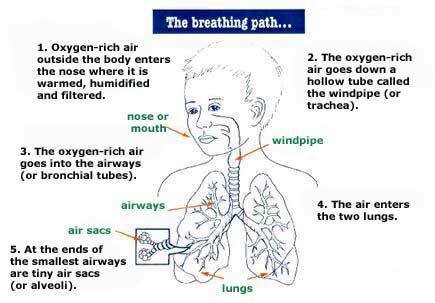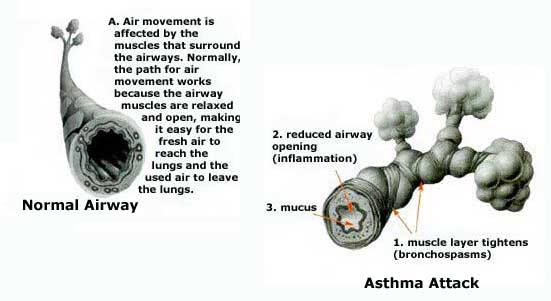What is Childhood Asthma?
Asthma is a chronic disease. With asthma, breathing is sometimes difficult due to these changes in the lungs:
- Swelling of the lining in the airways
- Tightening of the muscles around the airways (a spasm)
- Extra mucus in the airways
Asthma is not contagious. It is a lifelong disease which can be controlled with daily medications. Although asthma is a chronic disease, anyone with asthma can have an acute (sudden) attack of symptoms.
Causes of an Asthma Attack
Even if your child has no symptoms, being asthmatic means that there is almost always some inflammation / swelling in the airways.
Triggers can cause inflammation to increase, which may cause asthma symptoms to worsen. Every child has different and specific triggers. (See "Reducing Asthma Triggers in Your Home.")
Preventing Asthma Attacks
- Follow your asthma plan given to you by your child's doctor.
- Give medicines as directed.
- Keep your child away from smoke and known triggers, if possible.
- Consult your doctor if your child gets a cold or allergies.
Signs and Symptoms
- Repeated coughing
- Whistling sounds called "wheezing"
- Complaints like, "My chest feels tight," or, "My chest hurts"
- Activity decreased from the normal level
- Fast breathing
- Runny nose
- Increased work of breathing
During an Attack
- Stay calm and review the doctor's instructions.
- Give albuterol treatment.
- Offer your child frequent drinks of water or juice. Fluids help the mucus stay moist and loose.
- If your child is coughing, encourage him/her to cough up the mucus and spit it out in order to clear the airway.
- Give medications prescribed by the doctor as directed.
- Have your child rest quietly.
Call Your Child's Doctor If:
- Your child has increased difficulty breathing unrelieved by albuterol or other rescue medicines on your child's asthma plan.
- Your child breathes fast.
- Your child cannot take medicines or fluids by mouth.
- Your child repeatedly coughs until vomiting.
- Your infant / young child's chest sinks in while breathing.
Seek Emergency Care / Call 911 If:
- Your child continues to wheeze, breathe hard, or cough, even though rescue medications have been given.
- Your child becomes sweaty or complains of chest pain.
- Your child has a bluish color around his/her mouth.
- Your child's chest sinks in when he/she breathes in.
Related Medications
- Albuterol
- Budesonide (Pulmicort)
- Fluticasone (Flonase)
- Fluticasone and Salmeterol (Advair Diskus)
- Ipratropium Bromide (Atrovent)
- Ipratropium Bromide / Albuterol Combination
- Montelukast (Singulair)
- Prednisone
- Sodium Cromolyn





